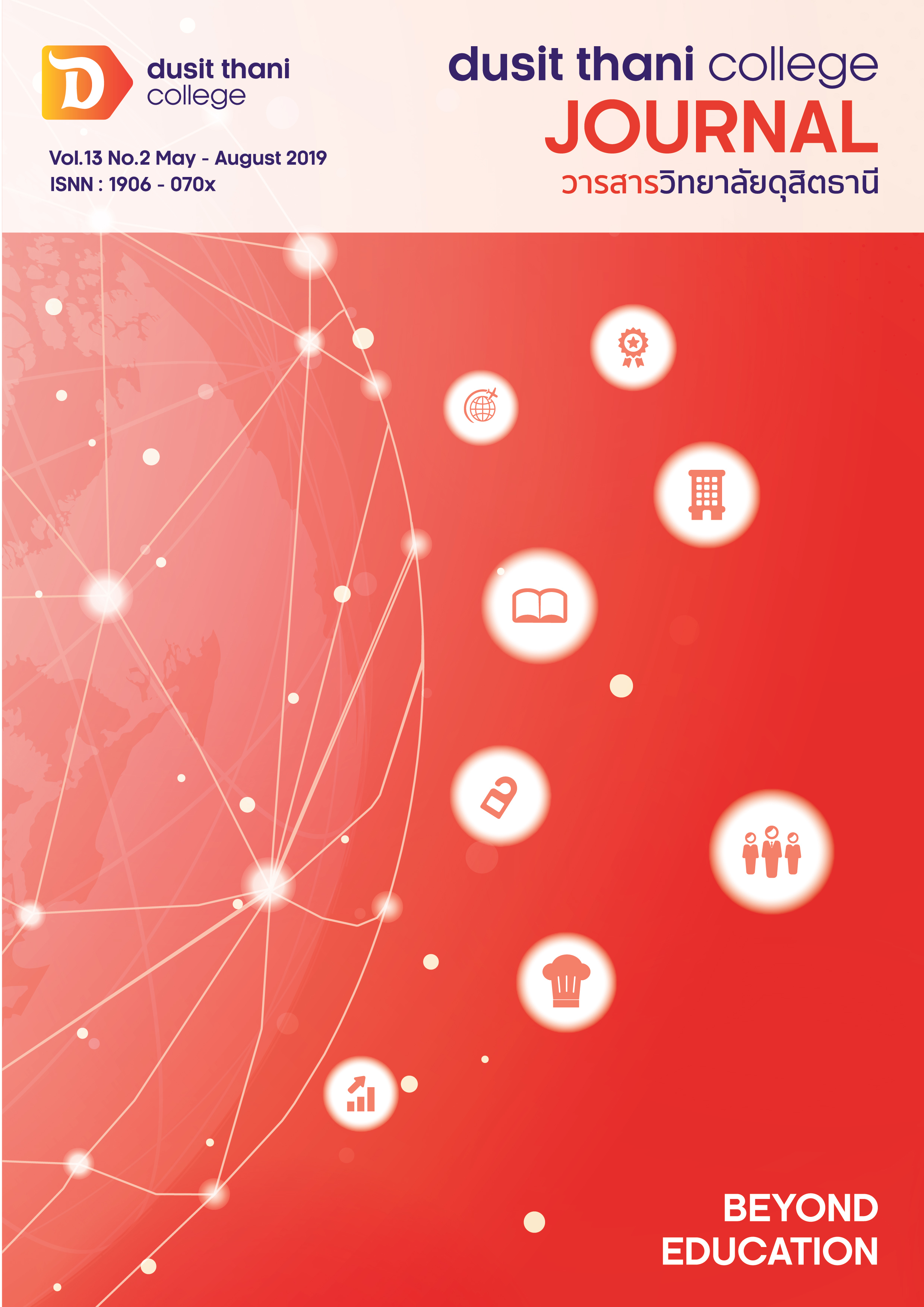The Tourism Image Influencing Loyalty of Tourists at Bali Hai, Pattaya Stepping into the Eastern Economic Corridor
Main Article Content
Abstract
This research aims to study tourism image influencing loyalty of tourists at Bali Hai Pier Pattaya, Chonburi beyond to Eastern Economic Corridor. The conduct of research collected from 380 Thai tourists visiting Bali Hai Pier, Pattaya by Multi-stage random sampling method. The results showed that image of tourism influencing to loyalty of tourists visiting Bali Hai Pier, Pattaya Beyond to Eastern Economic Corridor from Developed models was consistent with empirical data by Relative Chi-square=1.14, df=35, P-value=.25, GFI=.98, AGFI=.96, CFI=.99, RMR=.041, SRMR=.024, RMSEA=.019 and tourism image of tourism positive influencing to loyalty of tourists at Bali Hai Pier Pattaya by image of tourism could explain the loyalty of tourists for 69 percent.
Article Details
Article Screening Policy
- All research and academic articles to be published must be considered and screened by three peer reviews in the relevant field / article.
- All articles, texts, illustrations and tables published in the journal are the personal opinions of the authors. Editors don't always have to agree. And no responsibility whatsoever is the sole responsibility of the author.
- The articles to be published must never be published. Where did you first publish? And not in the consideration of other journals If the audit found that there has been a duplicate publication It is the sole responsibility of the author.
- Any article that the reader sees as being plagiarized or impersonated without reference. Or mislead the work of the author Please let the journal editor know it will be your greatest blessing.
References
2. Burns, P. and Novelli, M. (2008). Tourism development : growth, myths, andinequalities. Wallingford, UK. ; Cambridge, MA.: CABI.
3. Chen, C., & Tsai, D. (2007). “How Destination Image and Evaluative Factors Affect Behavioral Intentions?”. Tourism Management. 28: 1115-1122.
4. Champion, V., Skinner, C.C., & Menon, U. (2005).Development of a self-efficacy scale for mammography. Research in Nursing & Health. 28. 329–336.
5. DOT. (2012). Tourism Development Plan. 2012-2016. Accessible from
http://www.tourism.go.th. (in thai).
6. Darnell, A. C., & Johnson, P. S. (2001). Repeat visits to attractions: a preliminary economic analysis. Tourism management, 22(2), 119-126. http://dx.doi.org/10.1016/S0261-5177(00)00036-4.
7. Dumlag,K., Prangjarearnsre,K., Sreprajan,V., and Phangniran,B. (2015). Antecedents Affecting on Tourists’ destination loyalty of Phuket Province. Journal of the Association of Researchers 20(2),81-93. (in thai).
8. Esken N. (2013). International Tourists’ Perception of Pattaya City Image.
Thesis for Master of Communication Arts. Sripatum University Chonburi Campus. (in thai)
9. Gallarza, M.G., & Saura, I.G. (2006). Value dimensions, perceived value, satisfactionand loyalty: An investigation of university students’ travel. Tourism Management. 27(2): 437-452.
10. Gregory,R.J. (2015). Psychological Testing (7th Edition). Edinburgh Gate : Pearson Education Limited.
11. Jittangwattana, B. (2005). Sustainable Tourism Development.Bangkok:Thammasat Universit. (in Thai).
12. Jankingthong,W. (2014a). Destination Image in Thailand. Silpakorn Journal. 34(1) : 31-50. (in Thai)
13. Jankingthong,W. (2014b). Theory of Planned Behavior and Tourist Loyalty. Silpakorn Journal. 34(2) : 131-146. (in Thai)
14. Jayarman, K., Lin, S. K., Guat, C. L., & Ong, W. L. (2010). Does Malaysian Tourism Attract Singaporeans to Revisit Malaysia. Journal of Business and Policy Research, 5(2), 159-179.
15. Kozak, M. and Decrop, A. (2009). Handbook of tourist behavior : theory and practice. New York: Routledge.
16. Kotler, P. (1994). Analysis, planning, implementation and control. Prentice Hall International.
17. Likert, R. (1932). A technique for the measurement of attitudes. Archives of Psychology, 140.
18. NESDB (2017). Eastern Economic Corridor (EEC). Accessible from http://www.nesdb.go.th. (in thai).
19. NLA (2018). Recording Principles and Reason to Assemble Act of Parliament.
Accessible from www.eeco.or.th. (in thai)
20. Parasakul L. (2012). Tourist Behavior.Bangkok: chulalongkorn university (in thai)
21. Polit, D.F., Beck,C.T. (2006). The Content Validity Index:Are You Sure You Know What’sBeing Reported? Critique and Recommendations. Research in Nursing & Health. 29. 489–497.
22. Robinson, S., and Etherington, L. (2006). Customer loyalty: a guide for time travelers. New York: Palgrave Macmillan.
23. Suksawang, P. (2014). The basics of structural equation modeling. Pricesss of Naradhiwas University Journal, 6(2), 136 – 145.
24. Schumacker, R. E.,& Lomax, R. G. (2010). A beginner’s guide to structural equation modeling. (3rd Edition).New Jersey: Lawrence Erlbaum Associates
25. Schumacher, R. E. & Lomax, R. G. (2016). A Beginnerrs Guide to Structural Equation Modeling: (4th Edition) SEM. New York: Routledge.
26. Wang, X., Zhang, J., Gu, C., and Zhen, F. (2009). Examining antecedents and consequences of tourist satisfaction: A structural modeling approach. Tsinghua Science and Technology 14 (3) : 397-406.


